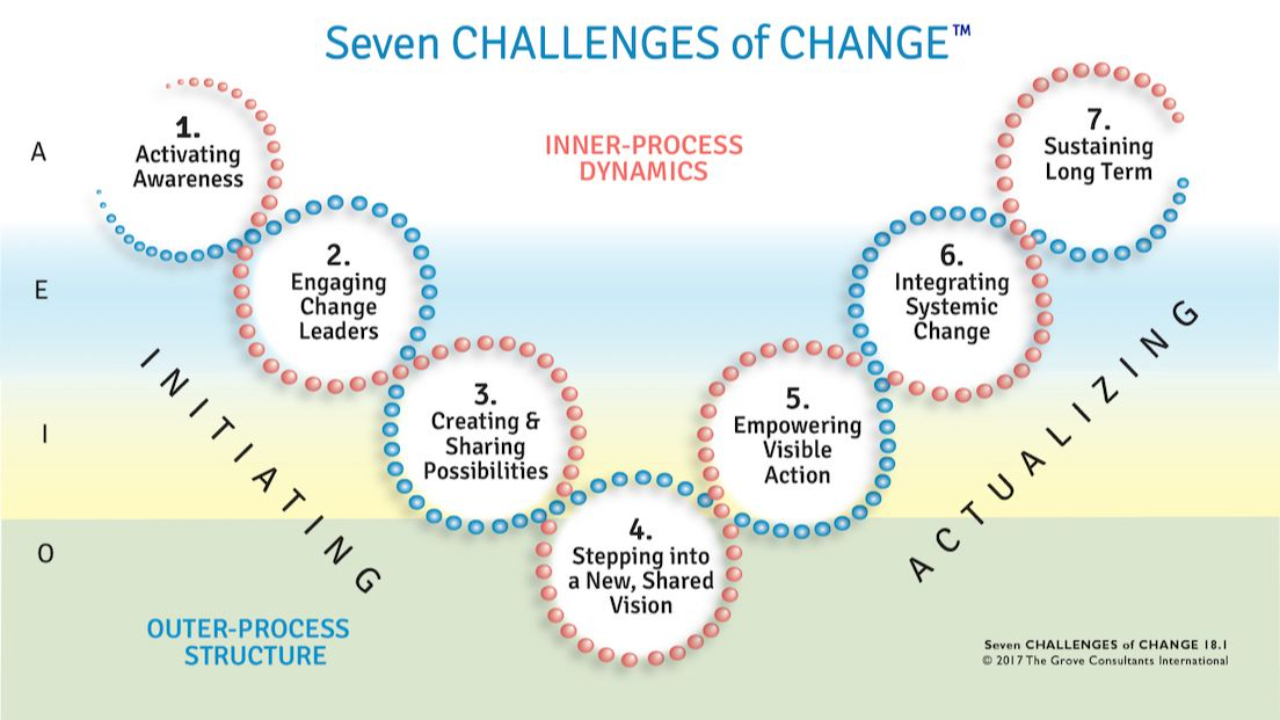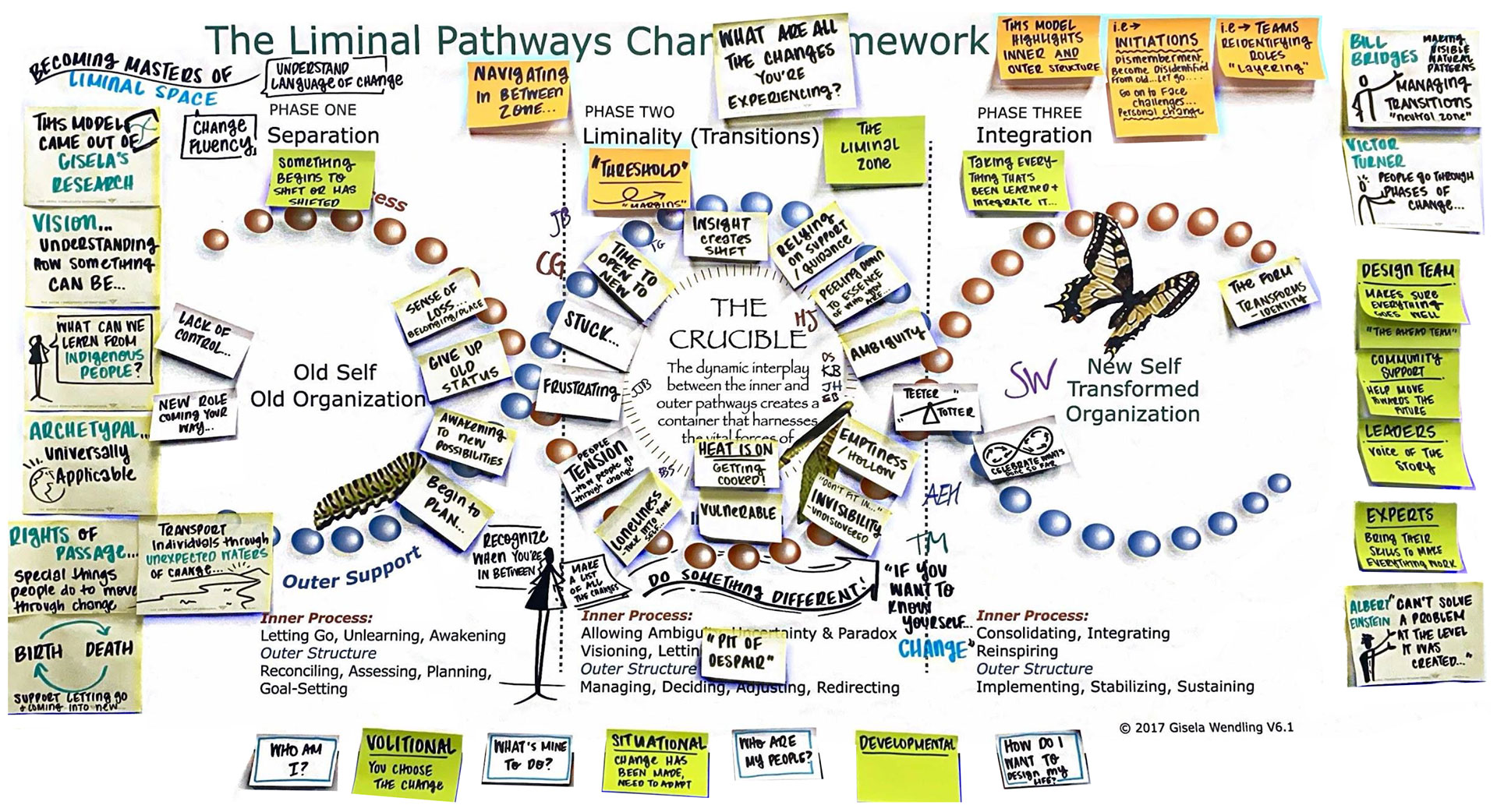Initiating Organization Change
Mar 15, 2023
Authors: Gisela Wendling, Ph.D. and David Sibbet
These times of continuing instability demand that we focus on how we work with change. In this article, Gisela Wendling, Ph.D., and David Sibbet explore how to work with the seven challenges of change they identified in their book Visual Consulting: Designing & Leading Change. The Seven Challenges of Change™ Framework is an integration of the Theory of Process, on which all of The Grove’s process frameworks are based, and the Wendling Liminal Pathways Change Framework™.
How do you begin activating awareness of a need to change? Here are some tips for getting started.
Tip One: Appreciate the dual nature of change
To guide change, it is important to pay attention to both the inner process dynamics and the outer process structure of change. The inner process deals with the psychological aspects of changing how we think, the way we behave, and the values we aspire to. This includes dealing with the challenging emotions that change can provoke (the orange beads on the model). The outer structures are the special activities needed to guide the change process forward (the blue beads).
Here are some examples of predictable inner dynamics. Appreciate that there may be many others. The key is to be aware of, include and work with these kinds of responses and feelings. Some of these feelings may seem like resistance. Remember that behind resistance is a sign that people are engaged and there may be a lot of valuable information to consider:
- Experiencing surprise
- Feeling shock/numbness
- Feeling hopeful (sometimes even excited)
- Assessing preparedness (can we really do this?)
Tip Two: Understand that different things drive the need to change
Change can come from three different sources. The change drivers might be:
- Situational: These are the changes that are largely initiated outside of one’s control such as economic shifts, the impact of climate change, losing a key employee, the drying up of a market or the changing culture of work as younger generations demand new ways of working.
- Developmental: People and organizations have natural life cycles. For example, the developmental goals of a teenager, versus a young adult, or someone in their late adulthood vary greatly. So, it is with organizations. A startup struggling with growth has different needs than a mature organization that wrestles with renewal.
- Volitional: These are the changes we choose to make aspirationally. We may choose to change jobs or move to another city. A leadership team may choose a new strategic direction.
These three sometimes combine, of course. Actively learn about these drivers and the needs that arise from them. For example, what might be a volitional change for the executives of an organization, might be a situational change for those who have not had a chance to give input on the new direction. Also, while a change might be volitional or situational, it might also initiate a new developmental phase.
Understanding these differences during initial conversations about a change can be very helpful to begin activating awareness. You will need energy, creativity, and understanding to move through any of these three kinds of change. Supporting employees to feel empowered and involved can make all the difference.

Tip Three: Actively engage people in recognizing that change is needed
In addition to identifying drivers of change, leaders, change consultants and facilitators can also do the following to provide outer support and awaken awareness of the need to change:
- Scan for system needs: Scans involve looking beyond the immediate indicators that a change is needed. Presenting symptoms are often an indicator of a deeper need. For example, what might be a breakdown in interpersonal relationships between employees or departments, after some analysis might actually reveal that it is a symptom of a badly designed but well-executed work process. It helps to enter with a wide focus, a systemic perspective, and many questions.
- Map drivers of change: A group process using Context Maps or simple lists can identify all the aspects that seem to be driving change (use the three types of change to generate questions). Then dot vote to see if people can agree on the most important. This activity activates the sense that change is required. Traditional force field analysis where you look at forces supporting change and forces resisting change is also a good activator.
- Identify stakeholders: Knowing who is or will be impacted by the change is critical before developing any kind of response. There may be internal and external stakeholders. This can be done simply with sticky notes or more thoroughly with a structured template looking at specific stakeholder interests and/or contributions, they might make to the change. Understanding these will also help you to know how and when to actively involve stakeholders in the change process.
- Interview for discovery: Talking to a good cross-section of people with a “discovery” mindset not only helps any leader or consultant get up to speed but activates awareness through the kinds of questions that are asked. Design questions that help people expand their sense of the drivers and context that is giving rise to the need to change. Equally important is communicating back what has been discovered. This builds trust that the process will be transparent. Of course, this feedback needs to be handled in a way that avoids focusing on specific individuals. An organizational change process that is intended to address wider system needs is not the right time to address employee performance issues.
- Understand & cultivate readiness: People don’t change like light switches. Even if circumstances change quickly, as they do in true emergencies, the transition to ways of thinking, behaving and working that can actualize the full potential of the change is a much slower process and takes time. People need to be brought along, especially with volitional change, but also when organizational dynamics are appreciated by some and not by others.

Change processes in complex organizations are very dynamic, and each change, even when guided well, unfolds in unique ways. The Seven Challenges of Change Framework is designed with the most basic challenges first, building toward realization as real decisions are made and everyone reaches a “no going back” stage. But the precise sequence can vary and stages can repeat. These dynamics are fully described in our book, Visual Consulting: Designing & Leading Change (fourth in the Wiley & Sons Visual Facilitation Series).
The Seven Challenges of Change Framework is the organizing model that David Sibbet and Gisela Wendling, Ph.D., used to write Visual Consulting. It has guided many Grove change projects such as the year-long visioning and change alignment process we led with the University of California Merced, a strategic visioning process with the College of Business Administration at Cal Poly Pomona as well as a year-long Leading Change program at the Environmental Service Division of the Metropolitan Council in Minneapolis.
Leading Change Consulting
Interested in working with us at your organization? We can co-design a holistic change process that includes meetings, asynchronous data gathering, and visuals that help galvanize forward movement. Whatever the need, our solutions ignite innovative idea generation and a possibility mindset.
